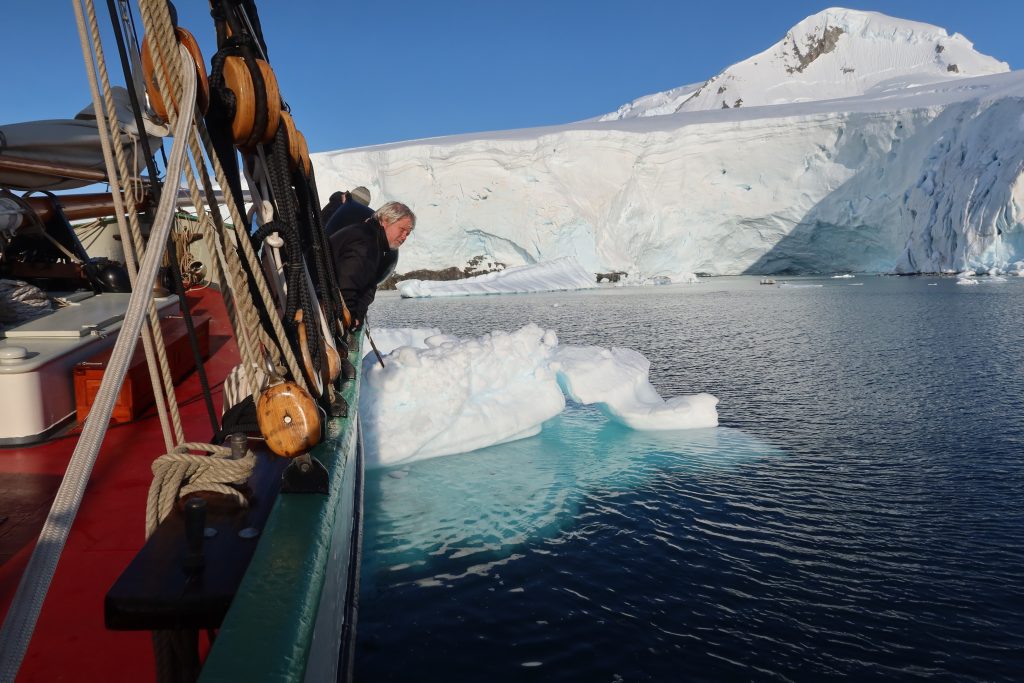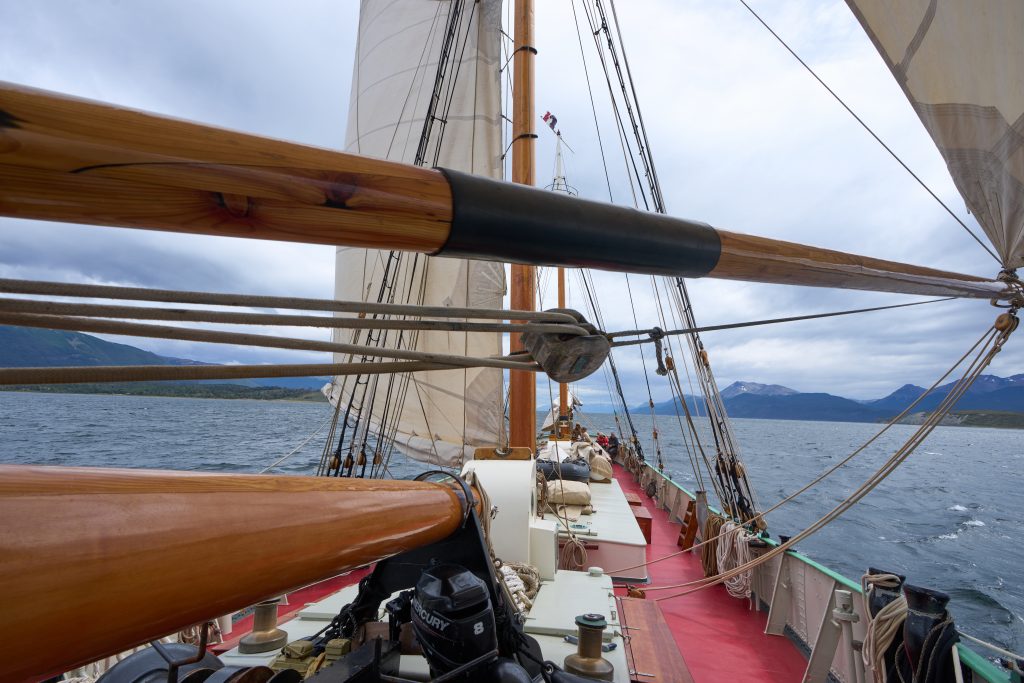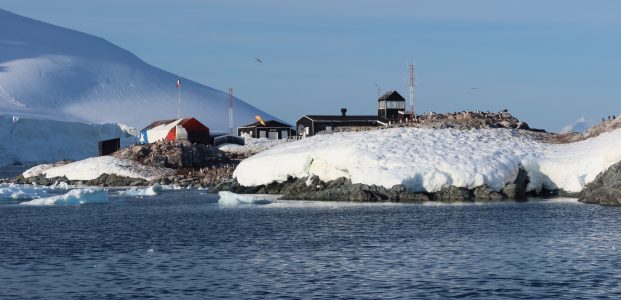We stayed a day at Waterboat Point, moving slightly further in and putting a second anchor down to weather the predicted storm. The long boat hook used for prodding the ice floes away was initially working overtime and even the Zodiac was used to do some ‘ice-nudging’ but very quickly the wind and tide completely emptied the ice back into the main channel and left us more or less ice-free. The 7th was spent relaxing and we had a movie session in the afternoon.

On the morning of the 8th we headed off after breakfast. The weather was still a little murky with a solid breeze and low cloud, but that just gave a gravitas to the scenery, hinting at more as the cloud occasionally lifted, but then pulling it away again as it closed in. We motored round to Danko Island and the weather cleared a bit to allow us to land and look around the gentoo penguin colonies on the island. Though we have seen lots of gentoo colonies, this one took things to another level. All the way up the hillside patches of rock were colonised, some hundreds of metres away from the shore and hundreds of metres up the hill with a network of pink tinged (penguin poo is pink from the krill they eat!) paths providing the penguin highways between colonies and down to the shore. It was the most extreme colonisation yet! The small ice floes on the beach gave the whole scene a more dramatic feel, but also added a comic dimension as we watched the stream of gentoos running backwards and forwards to their colonies slipping, sliding and falling their way through the maze created by the ice.
Back on board we headed off to the Melchior Islands. At least that was the initial plan, but after lunch the skipper announced that actually we were heading straight across the Drake Passage. The aim was to try and get north of a nasty depression running through the passage on the 10th. The first six hours or so were fairly quiet as we weaved through and past the western side of the Melchior Islands, but then we hit the left-over seas from the previous depression and we had a bumpy motorsail under just staysail and reefed mizzen for 12 hours or so getting through that. After that it stayed bumpy for a while but the wind went lighter and we had to carry on motorsailing.
That was at least until the engine stopped! The problem was quickly traced to the high-pressure side of the fuel system, but the solution was not so quick. An initial repair using a specialist epoxy was successful for 8 hours or so, but then went again, so another solution had to be found. An assortment of pipes and tools came constantly in and out of the engine compartment as various things were tried. Bits were removed from other equipment to see if they could be scandalised for the fuel feed and at various times the engine would be started to test the solution. Each time the skipper’s head would pop up out of the engine compartment and a hand waved across his neck indicated a lack of success. This continued for around 12 hours and we slowly drifted – the path on the chart plotter tracing a neat backwards zig zag looking a bit like a line of stitching. After one starting attempt we watched expectantly waiting for the skipper’s head to appear, but it didn’t. The engine kept running, the revs were increased and still no pop-up head. The revs were increased further, no head. After a few minutes hopes were high for this solution and, sure enough, it had worked. He had eventually welded the pipe and the weld held really well and we were off again.
This set our timetable back and so we continued motorsailing for a while. The wind then gradually increased and we could sail – just under staysail and reefed mizzen, but the peace and quiet was nice. Not for long though. Over the next 24 hours the wind increased coming in strong from just south of west, eventually hitting around 30 knots with gusts of up to 35 knots. We kept heading as far west as we could manage under these conditions as after this depression the wind was forecast to head back into the northwest and so we wanted as much westing as possible. The next day was a steady battle with the wind. The boat took it beautifully, but it was harder work for the crew. The skipper and mate took all the load of the helming with us providing moral support as deck ballast, getting battered by the wind and playing human pinball every time we came below, bouncing from side to side along the corridor. Dressing and undressing between watches added to the tally of bruises!
After around 18 hours the worst of the wind went through and before long the reefed main and jib were hoisted as well and we then had around 48 hours of lovely sailing – still keeping as far west as possible, but making the most of the breeze whatever the direction. Late on the evening of the 11th the main and jib finally had to come down as the wind eased too much to keep the sails filled and on the morning of the 12th we motored up towards the entrance into the Beagle Channel. The final night watch from midnight to 6am on the 12th was a fitting culmination to the passage. Though not totally clear, we had a hauntingly serene moonrise with dappled light over the waves and then around 5.15am a beautiful sunrise through the clouds. The distortion of the clouds and the refraction of the light made the sun look slightly like a Moomin as it rose through the clouds, but after 5 hours on watch you can imagine anything! We had two ships go past, both heading round Cape Horn in opposite directions and the wildlife count rapidly increased. Albatrosses (black-browed and wandering), shearwaters and prions all flew around the boat and bits of kelp in the water told us we were approaching land. Finally we spotted land – an island – and slowly other elements started to materialise. Sadly we missed Cape Horn as it was still 35 miles to the west and just out of view, but the approach was nevertheless beautiful.
As we came into the channels the amount of wildlife increased exponentially. Groups of seals popped their heads up enthusiastically to welcome us, a pod of dusky dolphins played around the bow and magellanic penguins swam nonchalantly around amongst the albatrosses and shearwaters. An amazing welcome into Chile and Tierra Del Fuego. From our entry waypoint into the channels it was then around 35 miles through the islands to Puerto Williams. The engine was the only solution for this stretch as the wind funnelled through between the islands. After an hour or so the wind increased to around 25 knots slowing progress somewhat, but somehow this didn’t matter. The mountains were clad with a luxuriant green blanket over them – trees – the first time we had seen this phenomenon in nearly two months! Just the top third or so peeked through with a dramatic demarcation of the tree line.

The island we were passing was Navarino Island and we worked our way along this shore anchoring around 3.30pm off Puerto Williams. It had taken five days to cross the Drake Passage. We had paid what they call the ‘Drake Tax’ with a fairly challenging combination of weather, from strong head winds to light winds with lumpy seas, but the Tecla took everything thrown at her in her stride.
The wheels of Latin American bureaucracy grind fairly slowly into action and as a result we had a nice break for 24 hours while they roused themselves into inactivity. Eventually at about 3pm on the 13th we were called ashore to be stamped into Chile though it is surprising how long stamping can take when you put your mind to it. But …. we are now officially allowed to walk around ashore and spent the rest of the afternoon and evening exploring the town. To walk from end to end of the town only takes around 15 minutes and while it has something of an outback feel about it, it is perhaps more kindly described as a work-in-progress. It is a friendly place and people smile and wave as you walk around, though the feral dogs, cows and horses are slightly distracting. Apparently they just wander round town as they feel like it, but the dogs do generally seem quite friendly and well cared for, so it is not in any way threatening. The materials in the souvenir shops in town seem to sell themselves as the town at the end of the earth and somehow this does feel appropriate, if a little harsh. However, the best way to feel better about our payment of the Drake Tax seemed to be a beer and so we found one of just two bars in town (which was also a restaurant) and mused on our literally incredible time in the sub Antarctican Islands and the Antarctic Peninsula.

